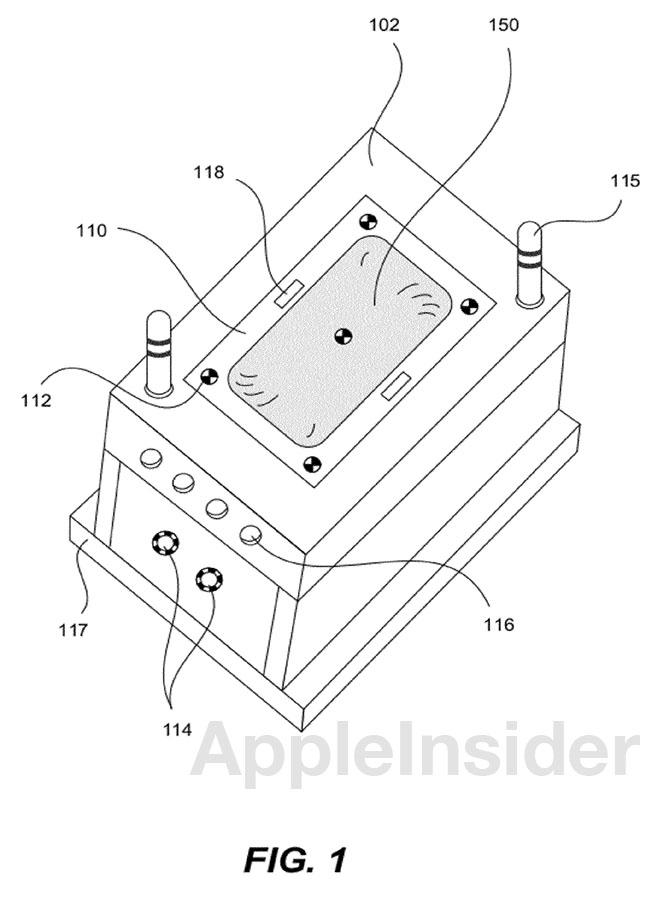Apple's U.S Patent No. 8,257,075 for a "Carbon composite mold design" describes the systems and methods needed to manufacture "aesthetically pleasing" parts from carbon fiber and other resin based composites.
While the applications of carbon fiber composite materials are many, Apple specifically notes that the invention can be used to "form outer housings for a laptop computer or other similar device." The patent may prove useful as an increasing consumer demand has pushed the industry toward slim and sleek portables with relatively heavy large screens. For example, the weight of the much-rumored next-generation iPhone's expected 4-inch screen could be offset by a carbon fiber monocoque.
It seems that the invention is aimed at larger devices like Apple's MacBook line, however, much like Sony's carbon fiber Vaio Z thin-and-light series.
Source: USPTO
From the patent's background:
As but one example, it would be particularly helpful if portable electronic device housings and components could be stronger and more durable than what is now typically provided in plastic parts that are formed via ordinary plastic injection molding processes. In particular, it would be beneficial if laptops, notebook computers, and other relatively large and heavy portable computing devices could have outer housings that are better able to protect the entire device from drops and other mechanical shocks.
The patent notes that traditional resin-based composites are made by layering resin-impregnated sheets of into or over a mold, which then cures under increased heat and pressure. Removal of the part can prove a hassle as the resins stick to the mold surfaces, which often requires manual prying and peeling from an operator. As a result, surface blemishes and other defects often occur.
Apple's proposed method looks to enable the mass-production of carbon fiber parts that have a consistent visual appearance by streamlining the manufacturing process.
The invention calls for a two-part mold, one a cavity and another portion "adapted to mate with the first," allowing composite parts to be formed in between. After curing, ejector pins located on one or both of the mold portions are used to separate the material from the mold body.
In another embodiment, a mold can have one or more internal fluid lines to help with cooling, a permanent release coating, and guide pins to accurately align the fiber sheets. Either a fluid or gas-actuated ejection system can also be employed for easy removal of the cured parts.
While Apple has shown no signs of using the advanced carbon fiber molding techniques in any future devices, the company may very well choose to do so in its push toward lighter and stronger products.
 Mikey Campbell
Mikey Campbell








-m.jpg)






 Christine McKee
Christine McKee
 Marko Zivkovic
Marko Zivkovic
 Mike Wuerthele
Mike Wuerthele

 Amber Neely
Amber Neely
 Sponsored Content
Sponsored Content
 Wesley Hilliard
Wesley Hilliard










44 Comments
If anyone can pull it off, it's Apple. I'm not a fan of carbon fiber though. It's just a nasty process to work with. Recycling that stuff is not a walk in the park. It doesn't seem to be Apple's style to be mass-producing that stuff.
Getting ready for the 7th generation Iphone, anyone?
Do [I]other[/I] companies patent stuff like this all the time? Apple was just granted a patent for a carbon fiber molding process... streamlining the method of molding carbon fiber. Were other companies on the brink of this new method too... but Apple just beat them to the patent office? Or is this one of those crazy ideas that only Apple would ever think of... yet it will be deemed "obvious" when everyone [I]else[/I] want to use it? Who wants to bet some other company will end up doing it... and get dragged into court? My point is.... starting today Apple has a patent on a new method of carbon fiber production. If you want to use it... you have to license it. Or come up with your [B]own[/B] method. I only bring it up because of the recent courtroom battles.
I would be surprised if prior art didn't pop up to invalidate this.
[quote name="sflocal" url="/t/152311/apple-patent-could-lead-to-carbon-fiber-macbook-housings#post_2181779"]If anyone can pull it off, it's Apple. I'm not a fan of carbon fiber though. It's just a nasty process to work with. Recycling that stuff is not a walk in the park. It doesn't seem to be Apple's style to be mass-producing that stuff. [/quote] They could use it for minor things like the Macbook hinges or the plastic Apple logos so they are less prone to cracking.